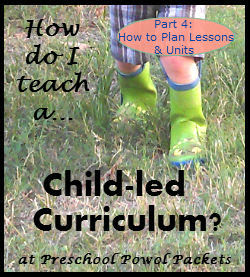How Do I Teach a Child-led Curriculum: How to Plan Lessons & Units

This week I am posting a 5-day series on a subject that is close to my heart: How Do I Teach a Child-led Curriculum?
Today, I am talking about how to plan lessons and units. Here is the rest of the schedule:
Thursday: How To Plan Lessons & Units in a Child-led Curriculum
Since this is a preschool blog, I will be discussing the entire subject with a focus on young children, but the principles can also be applied to older children (who can often have even more input in planning their schedules).
How to Plan Lessons and Units from Scratch
I had years of experience planning units and lessons before I ever began homeschooling, and I enjoy the process and the results. The process is very easy to describe, but can take time to become comfortable with. Here is a straight forward, step by step set of instructions for planning a 1-2 week unit.
1- What are your goals? Make a list (or mind-map) of what you want to accomplish or work on during the next week or two. Not sure where to start? World Book has a list of what is typically covered each year of school HERE.
2- What does your child want to study? You can ask them what they want to learn about and they are usually happy to tell you!
3- Create 5-10 lessons that teach or give your child the chance to experience the goals you've chosen within the subject your child wants.
Let's look at an example:
My 3-year old needs to practice his counting skills...he frequently skips "six" or "seven" when he counts to ten. My goal is: My child can count to ten correctly every time he tries.
My 3-year old is also in love with cars and trucks. He will be happy to practice counting if we're playing with cars and trucks. This is his subject.
5-10 lessons that integrate the two might include the following:
- An imaginative play game where we use a crane to move ten crates.
- An imaginative play game where we build ten towers out of blocks (each tower has ten blocks) and break them with a "wrecking ball"! Of course, we would count the remaining towers each time too!
- A board game where we move a car along a road with the numbers 1-10
- A walk down the street where we count all the cars and trucks
- A baking activity where we use car cookie cutters to make crackers and sort them in piles of ten
- A puzzle where they plug the numbers into their cutouts in order.
- A bin with number cut-outs or a counting activity in it.
You can tell I like to play!
If you read yesterday's post about routine, you know that we have several times during the day for these kinds of learning activities. At the beginning of the week, I can write down all the activities I've thought of, create any printables necessary, and prepare any other materials. This takes about an hour. Then, as each day comes I can choose one or two of them as my children's mood dictates during our School Time. Do they need a walk outside? Let's count cars. Do they need a quiet activity? Let's play the board game. Is it rainy? Do they want to build? Let's build towers! Whatever their mood needs, I have prepared a set of lessons that covers what I think is important the way they think is important. The child leads the learning with his or her interests and the adult makes sure a well-balanced education is achieved.
Here are a few more tips for lesson & unit planning:
1- Keep a list of year-long or course-long goals handy so you can choose from them for your unit plans, mark them off as accomplished, and refer to them to review.2- Use measurable, specific, realistic goals. My 3-year old can count to ten just fine sometimes, but other times he misses numbers. I want it to be perfect every time. He is capable of this.
3- Be flexible. If you don't have a chance to use all your lesson plans before your child decides his new love is actually bugs, that's okay! Go with the bugs. This is child-led. And if your child had so much fun with the wrecking ball tower building that he wants to do it every day for a month, that's okay too! It's great for a lot of skills!
A Shortcut for Unit & Lesson Plans
Nobody wants to "reinvent the wheel," right? Wouldn't it be nice if when your child decided to be interested in ladybugs, you could open a pre-made ladybug unit, grab the activities you want, and start school? Of course it would! There are hundreds of free units for young children available online (and hundreds more for sale)! Tomorrow I will share the Ultimate List of Free Unit Plans to make all your lives easier!How do you plan lessons and units? How much say do your children have in the process?
Enchanted Homeschooling Mom ~ Homeschool Gameschool ~ Are We There Yet? ~ Life with Moore Babies ~ No Doubt Learning ~ Mrs. Redd’s Classroom Blog ~ Proverbial Homemaker ~ My Joy Filled Life ~ Preschool Powol Packets ~ Adventures in Mommydom ~ Vicki Arnold ~ Only Passionate Curiosity ~ Living Life and Learning ~ Farm Fresh Adventures ~ 3 Dinosaurs
Disclaimer: These posts are based on my personal and professional experiences. What works well for our family may or may not be best for yours!

I may share at any of these parties!






Comments